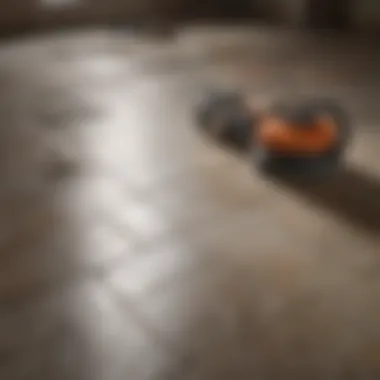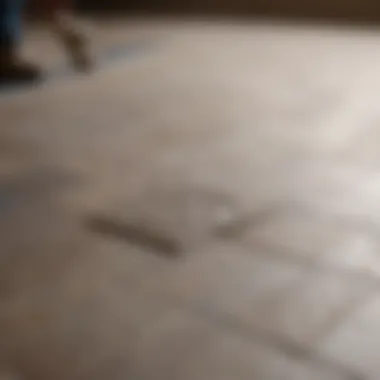Effective Techniques for Ceramic Tile Removal


Intro
Removing ceramic tile may seem like a daunting task, but it can be accomplished with the right knowledge and tools. This guide intends to give homeowners and DIY enthusiasts practical advice on how to effectively remove ceramic tile while maintaining safety and efficiency. Understanding the various techniques and tools available will empower you as you undertake this renovation project.
Ceramic tiles, favored for their durability and aesthetic appeal, often require removal due to reasons like damage, outdated styles, or an upgrade to more modern flooring options. The importance of removing tiles properly cannot be overstated. A mishandled removal can lead to damage in the subfloor, which may escalate costs and cause further complications.
In the sections that follow, we will explore key insights and trends related to ceramic tile removal. Then we will delve into practical tips and step-by-step guides that will facilitate the process for both seasoned DIYers and those new to home improvement projects.
Key Insights and Trends
Understanding current trends in the home renovation space can greatly inform your approach to removing ceramic tile.
Here are some important considerations:
- Sustainable materials: The shift towards eco-friendly flooring options is increasing. Many homeowners are looking for alternatives like bamboo or reclaimed hardwood once tiles are removed.
- Modern design aesthetics: Dining and living spaces are evolving towards minimalist designs. Many seek to replace complex tile patterns with simpler, more cohesive flooring styles.
- DIY culture: There is a growing trend of homeowners opting to take on renovation projects themselves. This often stems from the desire to save money and gain a sense of personal accomplishment.
Practical Tips and How-To Guides
To remove ceramic tile proficiently, there are essential steps to follow:
- Preparation:
- Assessing the tile:
- Technique for removal:
- For glued tiles, use a utility knife to cut around the edges, then try to lift them with a chisel and hammer.
- For mortar-set tiles, carefully break the tile with a hammer to remove them in sections.
- Post-removal:
- Take time to clear any residual adhesive from the subfloor. This step is crucial for preparing for the new flooring.
- Clear the area of furniture and other items.
- Gather your tools: you will need a chisel, hammer, and a safety cutter or jigsaw.
- Ensure you have safety equipment, such as gloves, goggles, and a dust mask to protect yourself from debris.
- Determine whether the tile is glued down or set in mortar. This can influence your approach.
"Proper preparation and selected techniques significantly impact the efficiency of tile removal."
Following these tips will make the tile removal process clearer and more manageable. Efficient tile removal leads to a smooth transition to your desired flooring.
With the insights and practical tips outlined, you are better equipped to tackle the challenge of removing ceramic tiles effectively.
Foreword to Ceramic Tile Removal
Removing ceramic tile is a significant task in home renovation. Understanding the reasons and methods behind tile removal is crucial for homeowners and DIY enthusiasts. This guide not only focuses on the removal techniques but provides insights that can influence decisions regarding flooring alternatives. A well-planned approach can save time and reduce frustration, making the process more efficient.
Understanding Ceramic Tiles
Ceramic tiles are popular due to their durability and aesthetic appeal. They come in various designs, colors, and finishes, making them suitable for many interior styles. These tiles are crafted from clay and fired at high temperatures, giving them strength and resistance to moisture. However, they can be challenging to remove once installed. Knowing their composition and installation technique helps in understanding the best removal practices.
Reasons for Tile Removal
Removing ceramic tiles is often necessary for several reasons. Whether it's due to damage, a desire for new styles, or repairs due to water damage, understanding the motivations behind tile removal allows for a focused approach.
Damage and Wear
Ceramic tiles, while durable, can suffer from damage and wear over time. Factors like heavy foot traffic, dropped objects, or improper installation can lead to cracks and chips. These imperfections can be not only unsightly but can also harbor dirt and bacteria. Removing damaged tiles helps maintain cleanliness and can prevent accidents due to loose or unstable tiles. Addressing this issue early can prevent further structural problems.
Style Change
Homeowners often choose to remove ceramic tiles to update the look of their space. Styles evolve, and preferences shift. Whether opting for a modern aesthetic or returning to a classic design, removing outdated tiles opens the door to new possibilities. This flexibility in design allows for a more personalized living environment. However, preparing for a change also means managing the effort and expense involved.


Water Damage Remediation
Water damage is another valid reason for tile removal. Leaks or flooding can compromise the integrity of the tiles and the underlying structure. In these cases, it is not just about removing tile but also addressing any mold or structural issues beneath. Effective remediation may involve more than just replacing tiles; it requires a thorough assessment of the subfloor and remediation of any moisture problems. Thus, prompt action to remove and repair water-damaged areas is crucial to prevent further complications.
"Timely removal of damaged tiles ensures a safer and more appealing home environment."
Preparation for Tile Removal
Preparation for tile removal is a crucial phase that lays the foundation for a successful project. Proper preparation not only prevents potential injuries but also ensures efficiency during the removal process. By understanding the necessary tools, assessing the condition of the tiles, and ensuring workspace safety, homeowners can tackle tile removal with confidence.
Tools and Equipment Needed
When it comes to removing ceramic tiles, having the right tools is important. Each tool serves a specific purpose, allowing the job to be completed effectively.
Tile Scraper
A tile scraper is a key tool in the tile removal process. It is designed specifically to help lift and remove tiles efficiently. The main characteristic of a tile scraper is its wide, flat blade that can fit under the edges of tiles. This design allows it to apply leverage, making it easier to pry tiles from the adhesive beneath. One advantage of using a tile scraper is that it minimizes the risk of damaging the underlying surface. However, for very stubborn tiles, it may require a bit of elbow grease. This tool is often favored because it is economical and easy to use for homeowners and DIY enthusiasts.
Crowbar
The crowbar, also known as a pry bar, is another indispensable tool in tile removal. Its long, flat shape allows it to exert force on tiles effectively. The crowbar's primary feature is its strength, which enables users to apply significant leverage to remove even the most embedded tiles. This tool is beneficial because it can also help in removing the tile adhesive if used properly. However, the downside is that it may cause more damage to the underlying floor if not used carefully. For those looking for a reliable and powerful option, a crowbar remains a popular choice.
Safety Gear
Safety gear is essential when undertaking tile removal, as the process can involve risks like sharp fragments and dust. Wearing proper safety gear can significantly reduce these risks. A key characteristic of safety gear includes sturdy gloves, goggles, and dust masks. This protective equipment is crucial because it shields the skin and eyes from sharp tile pieces, while the mask keeps dust inhalation at bay. While it might seem burdensome, neglecting safety can lead to serious injuries. Investing in quality safety gear is critical to ensure a successful and safe tile removal task.
Assessing the Tile Condition
Before proceeding with tile removal, assessing the condition of the tiles is vital. Homeowners should identify signs of damage or deterioration. Cracks, loose tiles, or signs of water damage can indicate that removal is necessary. Understanding the condition aids in planning the proper removal technique and can influence the choice of tools. This assessment not only facilitates a smoother process but also helps identify any underlying issues that may need attention after the tiles are removed.
Ensuring Workspace Safety
Creating a safe work environment is crucial when removing tiles. It minimizes the risk of accidents, ensuring the work can proceed smoothly.
Ventilation
Good ventilation is important during tile removal. Dust and debris can become airborne, potentially causing respiratory issues. Ensuring proper airflow in the workspace helps mitigate this risk. Opening windows or using fans can be effective in maintaining a safe breathing environment. While it may seem minor, many do not realize how much dust can accumulate during the process. Thus, monitoring air quality is essential for a safer experience.
Protective Equipment
Using protective equipment goes hand-in-hand with ensuring a safe workspace. Items such as heavy-duty gloves, safety goggles, and dust masks serve as barriers against potential harm. The main advantage of protective equipment is that it provides peace of mind, knowing that the risks are minimized. While it may take extra time to put on the gear, the protection it offers during the potentially hazardous tile removal process is invaluable.
Techniques for Removing Ceramic Tile
Removing ceramic tile is no simple task. It requires careful consideration of various techniques, taking into account the condition of the tile, the type of adhesive used, and the tools available. Each method has its own set of advantages and disadvantages, influencing the effectiveness and efficiency of the removal process. Understanding these techniques can lead to a smoother transition to new flooring options.
Manual Removal Techniques
Scoring the Grout
Scoring the grout is often the first step in manual tile removal. This method involves cutting into the grout lines surrounding the tiles. The main contribution of this technique is that it weakens the bond between the tile and the adhesive underneath. By scoring the grout, you can make it easier to lift the tiles without causing damage to them.


A key characteristic of scoring the grout is its simplicity. It does not require any heavy tools or machines, making it accessible for most homeowners. Additionally, it helps to minimize debris during the removal process.
However, one should note that while effective, this method does demand patience. Scoring must be done carefully to avoid damaging the adjacent tiles. It might also be less effective on tiles that are set tightly with strong adhesives.
Lifting the Tile
Once the grout is scored, the next step is lifting the tile. This technique involves using a tile scraper or crowbar to gently pry up the tile. The benefit of lifting the tile after scoring is that it generally prevents cracking or breaking, allowing for potential re-use of the tiles.
A notable feature of this method is its functionality; it directly targets the tile itself after the grout has been compromised. Lifting tiles manually can also be excellent for smaller spaces where powered tools may not fit.
However, lifting tiles can be labor-intensive. It requires physical effort and proper technique to avoid injury. There is also a risk of damaging the underlying surface if not done carefully.
Using Powered Tools
For larger areas or more challenging tasks, powered tools come into play. Their use can make the removal process faster and often more efficient. Nonetheless, they do require a certain level of expertise to operate safely and effectively.
Rotary Hammer Drills
Rotary hammer drills are particularly useful when dealing with stubborn or well-adhered tiles. This tool drills into the tile and subfloor, breaking the bond and allowing for easier removal. The primary benefit of using a rotary hammer drill is its power. It can make quick work of even the toughest tiles.
A unique feature is its versatility; it can be used for various types of tearing and drilling tasks, making it a valuable addition to a toolbox. However, the downside is that it can be quite noisy and may create a significant amount of dust. Proper safety measures must always be taken when operating this tool.
Floor Scrapers
Floor scrapers are another powered option that many find effective. These tools are designed specifically for removing floor coverings, making them ideal for ceramic tile removal. Their main characteristic is their ability to cover larger areas quickly. If you're removing tiles in spacious areas, this option may save time and effort.
They are particularly helpful in gathering loose debris after the tiles are removed, promoting a cleaner workspace. The downside, however, is that they can be more challenging to maneuver in tight spots and may require some practice to get used to operating them efficiently.
Removing Adhesive Residue
After the tiles are removed, you will likely face the challenge of adhesive residue left on the subfloor. Removing this is critical before any new flooring can be installed, as old adhesive can affect the bond of new materials.
Acidic Solutions
Using acidic solutions is a common method for dissolving stubborn adhesive remnants. These solutions work effectively for many types of adhesives used in tile installations. Their main advantage is the reduced labor needed when compared to manual scraping.
A unique feature is their chemical action, which can break down the adhesive without heavy physical labor. However, caution is needed, as these substances can be harmful to skin and surfaces. Proper ventilation and protective gear are essential when using acidic solutions to avoid health risks.
Scraping Techniques
Traditional scraping techniques continue to be a necessary restoration method following tile removal. Using scrapers can be effective in dislodging any remaining adhesive. This technique is beneficial because it gives you more control over the area being cleaned.
One unique feature of scraping is that it can be done without chemicals, making it more environmentally friendly. Yet, it can be time-consuming, especially if large areas need cleaning. There is also a risk of damaging the subfloor if too much pressure is applied.
In summary, when choosing techniques for removing ceramic tile, consider the size of the area, the condition of the tiles, and your level of expertise with tools. Each method discussed has distinct characteristics that can significantly impact your renovation project.
Post-Removal Considerations
Removing ceramic tile is only half of the task. Once the tiles are up, several key post-removal aspects warrant attention. These considerations ensure that your renovation progresses smoothly and lays a solid groundwork for whatever comes next. Evaluating the state of your subfloor, determining the right flooring options, and planning the next steps will enable a successful transition.
Subfloor Assessment


Inspect for Damage
Inspecting for damage after tile removal is crucial. This step involves checking the subfloor for cracks, uneven sections, or water damage. Identifying these issues early means that repair work can be addressed before laying down new flooring. A damaged subfloor can compromise the new installation, leading to future problems like sagging or creaking floors.
This assessment often uncovers underlying issues that can jeopardize the integrity of the new flooring. By prioritizing this investigation, you safeguard your investment in the home remodeling process. The expense or effort involved in repairing a damaged area now can save you significant costs and hassle later.
Determine Repair Needs
Determining repair needs goes hand in hand with inspecting damages. Once you identify areas of concern, it is essential to establish what repairs are necessary to ensure a stable base for your new flooring. This may include reinforcing the subfloor or replacing damaged boards or sections.
A well-repaired subfloor is vital for providing a durable surface that can withstand stresses from foot traffic. Assessing the needs accurately also helps avoid overspending on unnecessary repairs. The goal is to create a solid platform for your chosen flooring while not overlooking the potential for future issues.
Choosing New Flooring Options
Engineered Wood
Engineered wood is gaining popularity among homeowners seeking alternatives after tile removal. It consists of multiple layers, giving it resilience and stability. Its acoustic properties make it a good choice for reducing noise, adding comfort to any living space.
Unlike solid hardwood, engineered wood can better handle fluctuations in humidity, making it a reliable selection for areas prone to moisture. Furthermore, it offers a range of finishes to complement various aesthetic preferences. However, it is essential to note that engineered wood may not last as long as solid wood when subjected to heavy wear.
Luxury Vinyl Tile
Luxury vinyl tile is another versatile option following tile removal. It mimics the appearance of natural materials, such as wood or stone, while offering practical benefits like water resistance. This makes luxury vinyl an excellent choice for areas like kitchens or bathrooms, where moisture is a concern.
Moreover, it is easier to install than other flooring options, which can reduce labor costs. One potential downside is that while it is durable, it does not have the same long-term lifespan as some harder materials, such as ceramic or engineered wood.
New Ceramic Options
After removing old ceramic tiles, some homeowners may opt for new ceramic flooring. New ceramic options are available in various designs and styles that cater to current trends. They provide a durable and easy-to-clean solution, suitable for high-traffic areas.
One key characteristic of new ceramic tiles is their ability to withstand water and stains, making them ideal for both kitchens and bathrooms. However, the installation process can be labor-intensive, requiring careful preparation to ensure proper bonding to the subfloor. This can lead to higher costs and project time.
Remember, the decisions made in the post-removal phase significantly influence the outcome of your remodeling project. Thorough assessments and informed choices set the stage for successful renovation.
Tips for a Successful Tile Removal
Removing ceramic tiles can be a demanding task, but applying thorough tips can significantly enhance the process's success. Not only do these strategies save time, but they also reduce the likelihood of costly mistakes. Ensuring a successful tile removal project depends on planning, timing, and keen awareness of common pitfalls.
Planning and Timing
Effective planning is crucial when preparing for tile removal. Establish a clear timeline and a well-organized approach to the project. This involves assembling all necessary tools ahead of time, such as a tile scraper, crowbar, and safety gear. Understanding the scope of the project can help determine how long it will take and when to allocate the necessary time for completion. Unexpected delays often arise during removal, so having a buffer in your schedule can mitigate frustrations. This foresight sets the stage for a more manageable and less overwhelming endeavor.
Common Mistakes to Avoid
Rushing the Process
One of the most significant errors homeowners make is rushing the tile removal process. When individuals hurry, they often overlook crucial details, leading to more extensive work down the line. Not taking the time to gauge the condition of the tile and the underlying subfloor may result in unforeseen complications.
The essential characteristic of rushing is impatience. It negatively affects both efficiency and safety. When you are in a hurry, decisions can become rash, which might lead to damage of existing structures or injury to oneself. Removing ceramic tiles without proper assessment might also jeopardize the integrity of the subfloor. Therefore, it is essential to be methodical and adopt a paced approach towards tile removal.
Neglecting Safety
Another critical oversight is neglecting safety precautions. Safety should never be an afterthought in home renovation projects. Each step in the tile removal process poses risks, from sharp tiles to heavy equipment. Protecting oneself with appropriate safety equipment, including gloves, goggles, and dust masks, cannot be overstated.
The main characteristic of neglecting safety is complacency. Many individuals feel confident in their capabilities, leading them to underestimate risks involved in the project. This ignorance can have serious repercussions, such as injuries or long-term health issues stemming from exposure to dust and debris. Prioritizing safety features can safeguard against these hazards, making it a critical component of successful tile removal.
Remember, a successful tile removal project hinges on taking your time and ensuring proper safety measures. They are key to avoiding costly mistakes and fostering a smooth renovation experience.
Finale
Removing ceramic tile can seem daunting, but understanding the nuances of the process makes it manageable. This guide addresses not only the how-to aspects but also the why behind each step. Tile removal is not just a physical task; it is a gateway to new possibilities in home design.
Recap of Key Points
Throughout this article, various crucial elements have been highlighted regarding ceramic tile removal. Here are the key points:
- Preparation is essential. Gathering the right tools and ensuring workspace safety are foundational steps.
- Techniques matter. Different methods, whether manual or powered, can significantly affect the efficiency of the removal process.
- Post-removal assessment is important. Inspecting the subfloor and making informed decisions about new flooring can lead to better outcomes.
- Awareness of common pitfalls can save time. Rushing and neglecting safety can lead to frustration and potential injuries.



